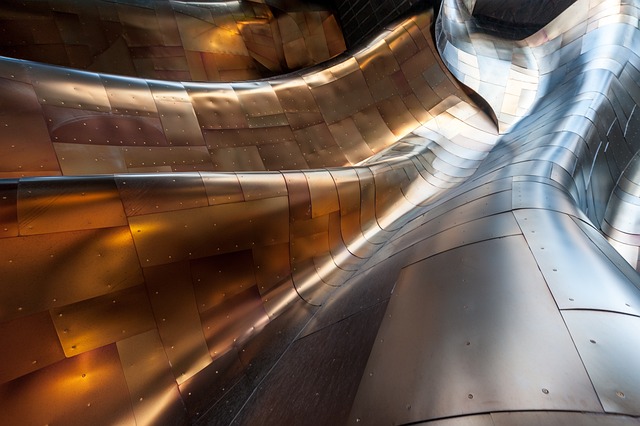Metal fabrication is a sophisticated process that plays a critical role in the production of precision commercial products. This field requires expertise in metal properties, adherence to industry standards, and strict client requirements. Advanced technologies like CNC machinery and robotic welding are employed to transform raw metals into precise components or structures efficiently and safely. The selection of appropriate metal alloys, optimization of manufacturing processes, and incorporation of cutting-edge technological advancements are key for enhancing productivity and sustainability in the industry. Understanding the unique properties of different metals is vital during the design phase to ensure functionality and aesthetics. The integration of CAD and CAM has revolutionized metal fabrication, enabling rapid prototyping and iterations that respond to complex demands. Innovative technologies like 3D printing and laser cutting have expanded the industry's capabilities, allowing for the production of complex geometries. Metal fabricators are at the heart of numerous sectors, providing precision-engineered components and structures that meet high standards across construction, aerospace, and beyond. Their proficiency in interpreting technical drawings, mastering metalworking tools, and complying with industry regulations makes them leaders in delivering bespoke solutions. Their blend of precision, innovation, and craftsmanship is evident in large-scale projects like the construction of advanced facilities and the creation of iconic public sculptures, showcasing their commitment to excellence and their significant contribution to both commercial applications and artistic achievements.
Exploring the intricate art of commercial metal fabrication, this article sheds light on the nuanced expertise required by industry professionals. With a deep dive into the evolution of metalworking techniques and their application in modern commercial settings, we highlight the key competencies that distinguish experienced fabricators. Their mastery not only drives innovation but also guarantees the robustness and functionality of various industries’ products. Through case studies, witness how these artisans transform raw metal into success stories, underscoring the critical role they play in our metallic landscape.
- Navigating the Complexities of Commercial Metal Fabrication: A Comprehensive Guide for Industry Professionals
- The Evolution of Metalworking Techniques in Modern Commercial Applications
- Key Competencies of Experienced Commercial Metal Fabricators: Skills and Expertise Shaping Industries
- Case Studies: How Mastery in Metal Fabrication Translates to Real-World Success Stories
Navigating the Complexities of Commercial Metal Fabrication: A Comprehensive Guide for Industry Professionals

Metal fabrication is a multifaceted process that demands precision, expertise, and a deep understanding of various metals’ properties to produce high-quality commercial products. Skilled commercial metal fabricators employ advanced technologies and techniques to transform raw materials into intricate components or structures, ensuring compliance with industry standards and client specifications. The intricacies of this field include selecting the appropriate metal alloys, designing efficient manufacturing processes, and adhering to safety protocols throughout production. Fabricators must also stay abreast of technological advancements to optimize productivity and sustainability in their operations.
In the realm of commercial metal fabrication, understanding the distinct characteristics of different metals is paramount. For instance, stainless steel offers superior corrosion resistance, making it ideal for environments exposed to harsh conditions. Aluminum, with its lightweight properties, is often chosen for applications where reduced weight is critical. Fabricators must consider these attributes during the design phase to ensure the end product meets functional and aesthetic requirements. Moreover, the integration of automated systems such as CNC machines and robotic welding enhances accuracy and consistency, which are essential for large-scale production and complex designs in commercial metal fabrication.
The Evolution of Metalworking Techniques in Modern Commercial Applications

Metalworking has undergone a remarkable evolution, propelled by advancements in technology and materials science, which have significantly expanded the capabilities of commercial metal fabricators. The advent of computer-aided design (CAD) and computer-aided manufacturing (CAM) has revolutionized the precision and efficiency with which complex metal structures can be conceived and produced. These digital innovations allow for rapid prototyping and iterative design, enabling fabricators to meet the diverse and intricate demands of modern commercial applications.
In tandem with these technological strides, the integration of advanced manufacturing techniques such as 3D printing and laser cutting has further transformed the metalworking landscape. These methods enable the creation of bespoke metal components with complex geometries that were previously unattainable. The versatility and adaptability of these technologies mean that commercial metal fabricators can now cater to a myriad of industries, from construction to aerospace, delivering high-performance, customized solutions that adhere to stringent quality standards. As such, the evolution of metalworking techniques continues to be a driving force behind innovation and efficiency in modern commercial applications.
Key Competencies of Experienced Commercial Metal Fabricators: Skills and Expertise Shaping Industries

Experienced commercial metal fabricators possess a multifaceted skill set that is indispensable in shaping various industries. Their expertise lies in understanding and manipulating metals to produce precision-engineered components and structures. These professionals are adept at reading and interpreting technical drawings, ensuring the accuracy of design specifications translated into tangible products. Mastery of metalworking machinery, from CNC lasers to press brakes, is a hallmark of their craft, allowing them to transform raw materials into complex assemblies with efficiency and precision.
The skillful integration of modern technologies such as computer-aided design (CAD) and computer-aided manufacturing (CAM) software further enhances the capabilities of these fabricators. This technological proficiency enables them to optimize material usage, reduce waste, and accelerate production times without compromising on quality or detail. Additionally, their knowledge extends to understanding different metal alloys, their properties, and how to work with each to achieve the desired outcomes for a project’s unique requirements. Their ability to navigate industry-specific standards and certifications is also crucial, ensuring compliance and safety across various applications, from construction to transportation and beyond.
Case Studies: How Mastery in Metal Fabrication Translates to Real-World Success Stories

Experienced commercial metal fabricators harness a symphony of precision, innovation, and craftsmanship to transform raw metal into bespoke solutions that cater to diverse industries. A case in point is the construction of a state-of-the-art manufacturing facility where the expertise of these artisans was pivotal in executing intricate design specifications. The project required not just the bending and cutting of metal sheets but also the integration of advanced materials and technologies to achieve optimal structural integrity and functionality. The fabricators’ adeptness in welding, forming, and finishing techniques resulted in a facility that stands as a testament to their skill and attention to detail.
Moreover, the prowess of these fabricators is evident in their ability to adapt to complex project requirements, such as the fabrication of large-scale architectural elements. A notable example includes the creation of an iconic public sculpture that presented unique challenges in terms of size, weight, and material composition. The metal fabrication team’s mastery was instrumental in not only meeting the artistic vision but also in ensuring the structural soundness of the piece. This project underscores the critical role these professionals play in translating design concepts into tangible realities, showcasing their indispensable contribution to the world of commerce and artistry alike.
metal fabricators play a pivotal role in shaping the landscape of various industries, from architecture to manufacturing. As this guide has explored, their mastery is not just rooted in technical skills but also in a deep understanding of industry-specific demands and innovative techniques that drive progress. The evolution of these crafts underscores the adaptability and ingenuity inherent in metalworking, highlighting its enduring significance in contemporary commercial applications. With a keen eye on precision and quality, seasoned professionals demonstrate how superior craftsmanship translates into real-world success stories, solidifying their indispensable value in the industrial sector. Metal continues to be a material of unparalleled versatility and potential, with skilled fabricators at the helm of its transformation into structures, products, and solutions that meet the challenges of modern demands.
